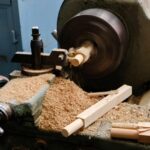Introduction
The Mortise Tenon woodworking joint is a form of wood-joining technique in which one end of a piece of wood is sculpted into a rectangular cavity or mortise and the other end is crafted to fit snugly inside this space as a tongue, or tenon. This style of joint allows for maximal strength and stability as the two pieces fitted together act as an incredibly strong unit that cannot usually be replicated in any other way.
Benefits: This versatile joint can be used with multiple types of wood and different shapes, allowing it to serve many purposes. From large furniture frames to smaller items like picture frames, it’s no wonder why the Mortise Tenon has become such a popular choice for woodworking projects both simple and complex. Furthermore, because it does not require the use of nails or screws it is also popular for creating cleaner-looking joints.
Applications: The Mortise Tenon can be found in various forms where two pieces are interlocked to strengthen them against external forces such as weight or tension. Therefore its applications range from secure table stands to heavy beams used in roof structures and floor joists. Moreover, its structure allows it to easily accommodate variations such as drawbore pins which are sometimes used when extra strength needs to be incorporated in a high-stress area like seat rails on chairs.
All these qualities make the Mortise Tenon joint an appropriate solution for any permanent internal structural connection across multiple materials, whether they’re thin boards held together on the side or slightly thicker materials combined in an X formation whose corners need more reinforcements with additional mortise & tenons.
Types of Mortise and Tenon Joints
The mortise and tenon joint is a classic hinge which has been used in woodworking since ancient times. It consists of two pieces of wood which are held together by an interlocking tabbed piece (the tenon) inserted into a slot or opening (the mortise). This type of joint is well-known for its strength, ease of assembly, and versatility in design.
Common varieties of the mortise and tenon joint include:
Through Mortise and Tenon: Here one component fully penetrates the other component from end to end. This type allows the components to be fastened with screws, glue, or traditional wooden pegs.
Stub Tenons: A stub tenon is just what it sounds like ” a piece that juts out of one component to fit into an opening in another component. They rarely penetrate completely through the second component but instead rely on screws or glue for stabilization.
Biscuit Mortise And Tenon: Biscuits are small elliptical shaped pieces cut into both components so that when joined they allow for greater stability then bolt/screw alone would provide. The combination also conditions your wood joints against movement due to humidity changes associated with changing temperatures.
Lap Joints: Here one half lap joint extends from each edge across the top of the joining boards, creating an overlapping effect similar to roof shingles. The included angle determines how tight or loose your connection will be; usually about 20 degrees provides the most reliable fitment.
Wedge Joints: This type uses angled wooden wedges that fit snugly into corresponding slots cut at right angles with one another on either side of the joint being connected. The many small edges ensure a strong grip as they dive deep into each edge providing stability and extreme strength once this joint is completed properly.
Advantages of Using a Mortise and Tenon
The mortise and tenon is one of the oldest and most widely used forms of woodworking joints. It offers several advantages for the woodworker: first, it is an incredibly strong joint that is highly resistant to pressure, tension and racking forces; second, it can be constructed quickly, allowing for precise alignment; third, it does not require a large number of tools to build, abandoning costly machinery such as biscuit joiners or pocket hole machines; fourth, it is relatively simple to execute taking into consideration some basic guidelines; lastly, after assembly it can be reinforced with nails, screws or glue as necessary. In this way, you have a joint that will provide great stability while remaining aesthetically pleasing. Mortise and tenon joints are one of the mainstays of modern carpentry due to their sheer strength and cost effectiveness.
How to Cut and Assemble a Mortise and Tenon Joint
The mortise and tenon joint is a classic woodworking joint that has been used for centuries, as it is both strong and attractive. To create a mortise and tenon joint, two pieces of wood are joined by inserting a tenon into a cut mortise in the other piece of wood.
To begin cutting the joint, use a table saw or circular saw to cut the tenon onto one piece of wood. Since the text will require two angled sides to fit into the mortise, use either a miter box and saw or set your blade on the table saw to make accurate angled cuts with repeatable accuracy. The depth of the cut should be equal to or slightly more than half the thickness of your material and remember to keep a minimum 5/16th inch thickness between the cheeks.
The next step is creating the mortise in which you will insert the tenon – this can be accomplished either by using an electric drill or chisel. If you choose to drill use your desired length auger bit and drill until you go 3/4s deep into your material, then finish off with a chisel; with chiseling create shallow marks at each end of your hole that are perpendicular to your intended hole size and eventually remove enough material with each plunge that forms an even depth throughout its length. Measure twice before cutting!
To assemble simply place glue around all surfaces that make contact between both pieces of wood including along the edges of where they meet, then attach each pieces together while securely clamping them until they dry completely ” allowing it adequate time to cure depending on what type of glue was used.
Now it’s time to put it all together: slide your tenon into place connecting both pieces making sure each edge touches firmly together than tighten clamps further if needed; once secure allow ample drying time, then inspect for any errors before enjoying a completed ‘mortise and tenon’ joint!
Selection and Use of the Best Joints for Specific Projects
The mortise and tenon joint is one of the oldest, strongest and most reliable woodworking joints. This joint consists of a square hole (mortise) cut into one piece of wood that fits tightly with a protruding tongue (tenon) cut out of another piece of wood. The two pieces are joined together forming a strong permanent connection that is used in many types of furniture construction and is frequently seen in chair frames, bed frames, tables and cabinet doors.
When used properly this type of joinery provides great stability for furniture or other objects where added strength and support are needed. Mortise and Tenon joints can be further reinforced using dowels or special screws to ensure increased strength when needed. When selecting which type of joinery to use for a specific project it is important to consider the size, weight, and function it needs to support. For larger structures, like chests or doors, mortise and tenon joints work best because they provide greater strength than other kinds such as dovetail joints. For other projects such as making small boxes or drawers, dovetails would be more appropriate since they are generally easier to produce quickly and take up less space on the finished object. It’s also important to remember that any type of joint should be reinforced with glue at all corners for extra durability especially if the item will getting reused often or bear any additional weight from being moved around too much.
Tips for Making Strong Mortise and Tenon Joints
Mortise and tenon joints are the most traditional type of woodworking joint. They are made with a portion called a mortise, which is cut into one piece of wood, and a piece called the tenon that fits inside. This type of joint is strong and long-lasting – but only if it is crafted properly! Here are some tips for making stronger and longer lasting mortise and tenon joints:
1. Carefully Measure – Take great care when measuring the sizes of your pieces so that the tenon fits perfectly inside the mortise. If you measure inaccurately, then even the strongest glue won’t help in binding these pieces together to create an effective joint.
2. Cut Deeply & Precisely – The fit should be tight, almost like a jigsaw puzzle. Making sure the dentitions on each side have been cleanly cut will help make sure there’s no slop when assembling your project. Make sure you don’t cut your mortises or tenons too shallow or too deep as they both need to fit snugly against each other; looser fittings will cause instability in your joint structure over time.
3. Use Quality Glue – Using high quality glue will ensure all parts hold securely without any post-assembly wobbling or loosening over time as this is usually caused by inferior glues not being able to form a strong bond within the joint’s parts due to clumping or uneven application methods.
4. Pin It For Extra Security ” To further increase security within your joints, try pinning them 10cm away from either side of the connection point with small brads (nails). This adds an extra layer to keep everything together, so even if there is slight movement due to wooden expansion for instance, it’ll stay secured firmly against one another instead of falling apart altogether.
Troubleshooting Common Issues with Mortise and Tenon Joints
Mortise and tenon joints are used in woodworking to create strong, long-lasting connections between two pieces of wood. However, it is not uncommon to run into problems when building these joints. The most common issues include:
1. Poor Fit ” If the mortise is too deep or wide then the joint will be loose or it won’t fit together properly. To avoid this issue always make sure that you are accurately measuring and cutting the mortises and tenons.
2. Loose Joints ” Loose joints can occur for a number of reasons including the wood shrinking after being cut, the glue being ineffective, or simply a poor fit due to inaccurate measurements. To prevent a loose joint careful measurement and high quality glue should be used to get the best connection possible.
3. Unsightly Gaps ” When building a joint using traditional methods gaps are likely to appear between the pieces of wood once complete; this is because they are relying on an adhesive to keep them together which cannot fill all of the space perfectly at once. To avoid this problem, you should use some form of clamping when gluing parts together such as carriers or strap clamps so that any small gaps that do occur will be minimized.
4. Cracks Around Tenons ” Cracks can often appear around tenons due to irregularities in either the mortise or tenon itself as well is inadequate clamping while gluing up your joint. Using dowels in both areas can help reduce stress build-up around these points and allow them to better resist tension from other sources such as multiple people opening/closing a door with a tenon hinge etc.. Ensure adequate clamping pressure is applied during glue up in addition to dowels for maximum strength and durability against cracks sometime down the line during everyday handling or conceivable abuse over time
Conclusion
The Mortise and Tenon joint is one of the strongest, most durable joints used in woodworking. It allows for large areas of wood to be joined together soundly and securely, while also offering a neat and attractive finish. The benefit of this joint is that it is resistant to shearing forces, perfect for assemblies that need to withstand the test of time. The process itself requires the precise measuring and cutting of both parts of the joint, but once complete offers an incredibly strong bond that can last for years.
Due to its strength, durability, and neat finish, the mortise & tenon joint has long been used for furniture making, railings and other carpentry projects. To utilize this type of joint effectively when constructing an item such as a chair or table leg, use timber or plywood with a width corresponding to the length of the tenon piece in order to form an even bond between parts. It is important that all pieces fit precisely before glueing; this needs to be done slowly so any necessary adjustments are made as you go. Once everything fits correctly and firmly into place, apply adhesive liberally on both sides until all parts join fully in order ensure maximum longevity.

Hi everyone! I’m a woodworker and blogger, and this is my woodworking blog. In my blog, I share tips and tricks for woodworkers of all skill levels, as well as project ideas that you can try yourself.





